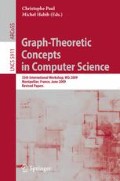Abstract
The Parity Path problem is to decide if a given graph G contains both an odd length and an even length induced path between two specified vertices s and t. In the related problems Odd Induced Path and Even Induced Path, the goal is to determine whether an induced path of odd, respectively even, length between two specified vertices exists. Although all three problems are NP-complete in general, we show that they can be solved in \({\cal O}(n^5)\) time for the class of claw-free graphs. Two vertices s and t form an even pair in G if every induced path from s to t in G has even length. Our results imply that the problem of deciding if two specified vertices of a claw-free graph form an even pair, as well as the problem of deciding if a given claw-free graph has an even pair, can be solved in \({\cal O}(n^5)\) time and \({\cal O}(n^7)\) time, respectively. We also show that we can decide in \({\cal O}(n^7)\) time whether a claw-free graph has an induced cycle of given parity through a specified vertex.
This work has been supported by EPSRC (EP/D053633/1) and the Actions de Recherche Concertées (ARC) fund of the Communauté française de Belgique.
Access this chapter
Tax calculation will be finalised at checkout
Purchases are for personal use only
Preview
Unable to display preview. Download preview PDF.
References
Arkin, E.M., Papadimitriou, C.H., Yannakakis, M.: Modularity of cycles and paths in graphs. Journal of the ACM 38(2), 255–274 (1991)
Arikati, S.R., Peled, U.N.: A linear algorithm for the group path problem on chordal graphs. Discrete Applied Mathematics 44(1-3), 185–190 (1993)
Arikati, S.R., Peled, U.N.: A polynomial algorithm for the parity path problem on perfectly orientable graphs. Discrete Applied Mathematics 65(1), 5–20 (1996)
Arikati, S.R., Rangan, C.P., Manacher, G.K.: Efficient reduction for path problems on circular-arc graphs. BIT 31(2), 182–193 (1991)
Berge, C.: Färbung von Graphen, deren sämtliche bzw. deren ungerade Kreise starr sind. Wissenschaftliche Zeitschrift der Martin-Luther-Universität Halle-Wittenberg, Mathematisch-Naturwissenschaftliche Reihe 10, 114 (1961) (in German)
Bienstock, D.: On the complexity of testing for odd holes and induced odd paths. Discrete Mathematics 90(1), 85–92 (1991)
Chudnovsky, M., Cornuéjols, G., Liu, X., Seymour, P.D., Vušković, K.: Recognizing Berge Graphs. Combinatorica 25(2), 143–186 (2005)
Chudnovsky, M., Robertson, N., Seymour, P.D., Thomas, R.: The strong perfect graph theorem. Annals of Mathematics 164, 51–229 (2006)
Chudnovsky, M., Seymour, P.D.: The three-in-a-tree problem. Combinatorica (to appear), manuscript, http://www.columbia.edu/~mc2775/threeinatree.pdf
Chudnovsky, M., Seymour, P.D.: Three-colourable perfect graphs without even pairs (submitted for publication), manuscript, http://www.columbia.edu/~mc2775/K4evenpairs.ps
Chvátal, V., Sbihi, N.: Recognizing claw-free perfect graphs. Journal of Combinatorial Theory, Series B 44, 154–176 (1988)
Corneil, D.G., Fonlupt, J.: Stable set bonding in perfect graphs and parity graphs. Journal of Combinatorial Theory, Series B 59, 1–14 (1993)
Derhy, N., Picouleau, C.: Finding induced trees. Discrete Applied Mathematics 157(17), 3552–3557 (2009)
Everett, H., de Figueiredo, C.M.H., Sales, C.L., Maffray, F., Porto, O., Reed, B.A.: Path parity and perfection. Discrete Mathematics 165-166, 233–252 (1997)
Everett, H., de Figueiredo, C.M.H., Linhares Sales, C., Maffray, F., Porto, O., Reed, B.A.: In: Ramirez-Alfonsin, L., Reed, B.A. (eds.) Perfect Graphs, pp. 67–92. Wiley, Chichester (2001)
de Figueiredo, C.M.H., Gimbel, J.G., Mello, C.P., Szwarcfiter, J.L.: Even and odd pairs in comparability and in P 4-comparability graphs. Discrete Applied Mathematics 91(1-3), 293–297 (1999)
Fonlupt, J., Uhry, J.P.: Transformations which preserve perfectness and H-perfectness of graphs. Annals of Discrete Mathematics 16, 83–85 (1982)
Hoàng, C.T., Le, V.B.: Recognizing perfect 2-split graphs. SIAM Journal on Discrete Mathematics 13(1), 48–55 (2000)
Hsu, W.-L.: Recognizing planar perfect graphs. Journal of the ACM 34(2), 255–288 (1987)
LaPaugh, A.S., Papadimitriou, C.H.: The even-path problem for graphs and digraphs. Networks 14, 507–513 (1984)
Lévêque, B., Lin, D.Y., Maffray, F., Trotignon, N.: Detecting induced subgraphs. Discrete Applied Mathematics 157(17), 3540–3551 (2009)
Linhares Sales, C., Maffray, F.: Even pairs in claw-free perfect graphs. Journal of Combinatorial Theory, Series B 74, 169–191 (1998)
Meyniel, H.: A new property of critical imperfect graphs and some consequences. European Journal of Combinatorics 8, 313–316 (1987)
Roussopoulos, N.D.: A max {m,n} algorithm for determining the graph H from its line graph G. Information Processing Letters 2, 108–112 (1973)
Sampaio, R.M., Sales, C.L.: On the complexity of finding even pairs in planar perfect graphs. In: Brazilian Symposium on Graphs, Algorithms and Combinatorics 2001, Fortaleza. Electronic Notes in Discrete Mathematics, vol. 7, pp. 186–189 (2001)
Satyan, C.R., Pandu Rangan, C.: The parity path problem on some subclasses of perfect graphs. Discrete Applied Mathematics 68(3), 293–302 (1996)
Tarjan, R.E.: Decomposition by clique separators. Discrete Mathematics 55, 221–232 (1985)
Trotignon, N.: Graphes parfaits: Structure et algorithmes. PhD Thesis, Université Joseph Fourier - Grenoble I (2004) (in French)
Whitesides, S.H.: A method for solving certain graph recognition and optimization problems, with applications to perfect graphs. Annals of Discrete Mathematics 21, 281–297 (1984)
Author information
Authors and Affiliations
Editor information
Editors and Affiliations
Rights and permissions
Copyright information
© 2010 Springer-Verlag Berlin Heidelberg
About this paper
Cite this paper
van ’t Hof, P., Kamiński, M., Paulusma, D. (2010). Finding Induced Paths of Given Parity in Claw-Free Graphs. In: Paul, C., Habib, M. (eds) Graph-Theoretic Concepts in Computer Science. WG 2009. Lecture Notes in Computer Science, vol 5911. Springer, Berlin, Heidelberg. https://doi.org/10.1007/978-3-642-11409-0_30
Download citation
DOI: https://doi.org/10.1007/978-3-642-11409-0_30
Publisher Name: Springer, Berlin, Heidelberg
Print ISBN: 978-3-642-11408-3
Online ISBN: 978-3-642-11409-0
eBook Packages: Computer ScienceComputer Science (R0)

